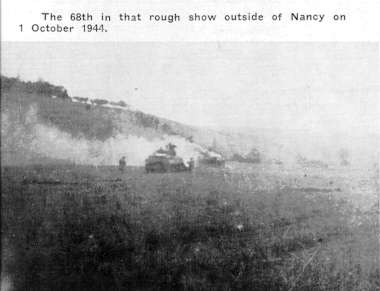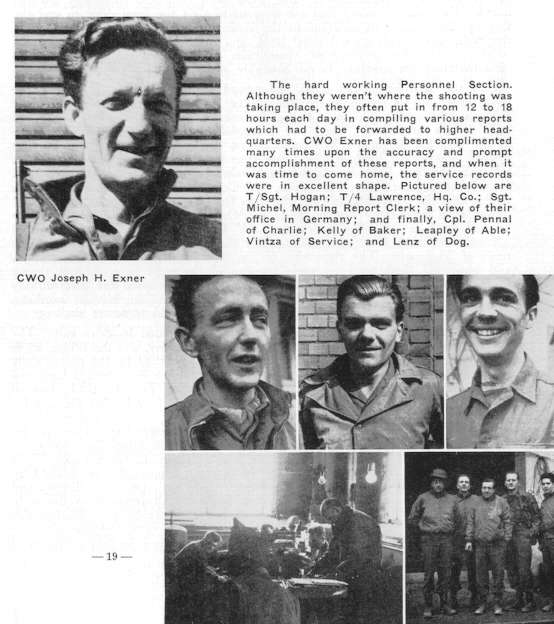Lorient |
Table of Contents |
Nov - Dec Offensive |
Lorient |
Table of Contents |
Nov - Dec Offensive |
On
the eighteenth of September, we were relieved from CCA and joined Reserve
Command. The next day Company "D" minus the platoon which was still at
Brest, moved out for the "Colombay area" and on the twentieth the battalion
moved out at 0910 and headed for Colombay; we closed in bivouac fourteen
miles west of Troyes on Route N-60: The following day the Battalion continued
marching to the east and closed in a tactical bivouac in the vicinity of
Colombay at 1745, and was relieved from Reserve Command and assigned to
Division control. We were subsequently assigned to XX Corps. On the 23rd
of September we were ordered to join CCR at Toul, but on arrival there
we were met by Corps Liaison officer and ordered directly to Briey. We
remained at Briey until September 29th when we were ordered to move to
Nancy. At 1800 the column was closed of Saulxures-Les Nancy and troops
were billeted in the town, The following day we made minor shifts in troop
billets and the CP moved to Tomblaine. At 1830 we were alerted to move
to an assembly area in the vicinity of Pettencourt where we closed at 2340.
Our duties hadn't been arduous at Briey; quite the contrary, we had become quite comfortable there in the enviable position of the corps reserve, but then toute de suite came the fast road march, the assembly at Pettencourt, and we were back in the thick of it again. This was to be a line-strengthener, a nasty limited objective attack, designed to secure for the army more advantageous positions from which to launch later a large scale offensive. In other words, elements of the division would be attacking, and there draw the undivided attention of the krauts in front of us.
The battalion
jumped off at 0600, after a considerable artillery preparation, with Companies
"A" and "B" up and abreast. Companies "A" and "B" of the 9th AIB followed
in the second wave and Company "C" (--) of 603rd T.D. Battalion disposed
with one platoon to cover the left flank of the attack, and the other assembled
as a covering force in the event of an enemy counter-attack. Companies
"D," 68th, and "C" 9th AIB were initially in task force reserve, while
Company "C" 68th was in division reserve. Our objective was the high

ground
south of the Seille River east of Gremecy Wood. We were operating in this
coordinated attack under CCR, and at the same time CCB was making a similar
attack on our left flank in the woods.
The attack was methodically carried out, and by 1040 our objective was obtained by the first and second wave. The control of all leading elements was exceptionally good under conditions which lent to confusion, for enemy small arms fire was heavy, and their artillery fire was extremely heavy, and also the infantry were not employed at the proper time. At 1100, Company "D" was committed to hold the ground west of Chambrey, covering the elements and screening the task force's right flank, While the lead elements waited, there for elements of the 35th Division to come up and secure this hard-won objective, the enemy artillery became intense, and our sharp-shooting Assault Gun Platoon was called up to nullify direct fire weapons to our left front in a well defiladed position; they consequently poured merciless fire on the positions with excellent observed results. At 1330, the task force withdrew to its forward rally point prepared to support the doughs in the event of an enemy counter-attack. The artillery fire continued to rain on our vulnerable positions, but finally at 1940 the battalion went into reserve and assembled in the vicinity of Pettencourt, while Company "C" remained in position to cover the withdrawal of the force and to support the 35th doughs as they perfected their defensive positions on the objective. Then, at 2340 Company "C" was relieved and returned to the battalion assembly area. Its mission had been accomplished, but the battalion had suffered greatly in so doing; our casualties were four killed in action, 24 wounded, and a vehicular loss of 2 tanks destroyed. But the greatest blow was the loss of Captains Polk and Bland who died in the heroic performance of their duties, and Major Brown, who had two tanks shot from under him and was seriously wounded while trying to get to the third. There were countless acts of heroism during this costly action; it would take pages to recount one tenth of them. There was the Recon Platoon intrepidly blowing paths through a mine field under terrific artillery fire; there was Lt. Olan Hafely, who took over "A" Company, when Captain Polk was killed, and successfully led it to its objective, and who was all the while seriously wounded. These are only two of many.
The next day, the battalion moved back to billets in Tomblaine; we left "C" Company near vicinity of Pettencourt, for they were assigned the mission of blocking Route N-74, and were attached to a Third Army task force. As you can well imagine, the men were exhausted, and we were badly in need of reorganization and rest, so Col. Davall prescribed the maximum rest possible and the men bedded down. Before going any further, and before the memory of bloody October 1st fades away (most of us will never forget it), we would like to quote one statistic which sums up the action in a few words: Of the thirty-seven tank commanders in the first attack wave, eighteen were either killed or wounded.
One whole day of rest passed without interruption, and things began to look a little more normal; it has never failed to amaze us how quickly these Davallmen recovered from such a wracking ordeal, Then on the following day, Task Force Britton, composed of Company "B" 68th, Company "D" 9th AIB, and one platoon of the 603rd T.D.'s, moved out to take over the Third Army road block, and relieved "C" Company. General Patton was taking no chances on losing our hard-won ground to an enemy counter-attack.
As the
remainder of the outfit rested and reorganized, TF Britton, with Major
Britton, Battalion Executive Officer, in command, and 2nd Lt. Burns,
his exec,
completely organized and consolidated the position and got set for an enemy
counter-attack. The expected attack never came, although Jerry's artillery
never stopped, and each night we went to sleep to the tune of screaming
shells and the washing machine sound of Bed Check Charlie (kraut observation
planes). Then, on the sixth of October, Task Force Britton was relieved
by elements of the 86th Cavalry Reconnaissance Squadron, and returned to
the battalion area. However, immediately upon their return, the battalion
was put on a two hour alert status, and all commanders and platoon leaders
were out for a reconnaissance in the vicinity of Chenicourt. Was another
of those linestraighteners in the making?
The next day, the battalion was relieved from CCR and assigned to CCB, with "B" Company being attached to Task Force Godfrey (an armored infantry task force). We were alerted to move at 0700 the following morning. Then, at 0730, Task Force Davall moved out to an assembly area in the vicinity of Leor. A short while later we moved a little farther north and closed in a tactical bivouac at Chenicourt at 1530.
This was to be another limited objective attack, and the whole division was to occupy more advantageous ground north of Nancy, in preparation for the push which we all felt was building up. TF Davall moved out at 0630 for the line of departure, and jumped off in its attack on the BOIS DE TRAPPE at 0740. Enemy small arms, mortar, and artillery fire was intense, but ours was more so, and by 1300 the objective had been taken. Our division artillery, supported by heavier corps howitzers, poured several TOT's on the kraut positions and these had a devastating effect. Elements of the 6th Infantry Division were supposed to take over the objective once we had gained it, and while we were waiting for them to take over, a small counter-attack developed, but was repulsed. It seemed as though the 80th would never get around to relieving us and we sweated it out until 1600 when they completed the job of tying in and digging in on the position. Then the task force moved out to a bivouac in the vicinity of the Agincourt from which point we were to support the 80th Division in the event of counter-attack. Our move was very difficult, as it was as black as pitch, the rain was coming down in torrents, and Jerry never stopped shelling us, but we finally closed at 0420 on the tenth.

We remained in the position uneventfully until October 19th, and while we were not called upon to assist the 80th, it rained cats and dogs all the time, and Jerry, if he thought things were getting too peaceful, would occasionally lob over some big stuff. Everyone was completely miserable, and was not a bit sorry when we were eventually relieved. So, we moved back to Tomblaine to our billets, and stayed there without interruption until November seventh.
We spent
this period of tactical inactivity in rest, rehabilitation and maintenance.
Also, once were shaken down, and prepared for anything, passes to Nancy
were granted, we had daily moving pictures, and beer was plentiful. Dances
were organized, the local belles invited, and friendships between French
and Americans mushroomed here and there.
And all
this time, supplies were being built up and stored, equipment was replaced,
tanks tuned up. Toward the end of the above mentioned period, there was
a perceptible step-up in the tempo; plans were made and discussed, and
while all was top secret, there was that feeling in the air. Something
big was up! Then, we were all told what it was all about. We were going
to crack Jerry's outer defensive shell, and then push to the Saar River,
through the Siegfried Line if we caught him sufficiently off balance, keep
going to the Rhine if we could drag him down, and knock him out! All the
armies poised all along the line were to jump off. And we knew where the
armor would be, as usual, out in front, running broken field, if we were
shaken loose.

NOTE: Remove question mark from address below when sending email
This page is maintained by Bruce Frederick, EMAIL
.
Last updated: June 12, 1999.